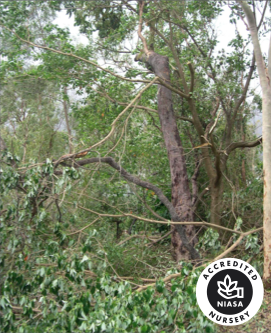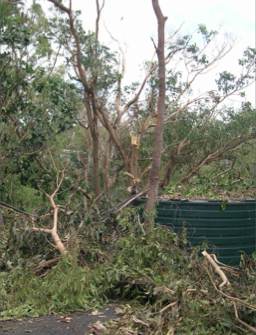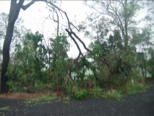Local North Queensland information for Local North Queenslanders.
Actually, there’s no such thing as a totally cyclone-proof garden. Nevertheless, some gardens withstand strong blows and cyclones better than others…
 The secret is not so much in the choice of plants but in the gardening practices applied to garden preparation and maintenance.
The secret is not so much in the choice of plants but in the gardening practices applied to garden preparation and maintenance.
The biggest problem in a cyclone is trees which blow over because their roots are not strong enough to anchor them in the ground. While some species are naturally more deep-rooted than others, all plants will have puny, shallow root systems if they are planted in tiny holes in hard ground. If a plant is to develop a large and healthy root system, the soil must be well loosened so that the roots can grow out into it.
- The first rule of cyclone-proofing is to thoroughly prepare your ground before you plant your plants.
- The second key to a cyclone-proof garden is pruning.
If a plant has more foliage than its root system can support in a gale, then it will blow over. If a plant is extremely thick and bushy, then it will present a solid wall to the wind, and in a cyclone will be more prone to blowing over than its more open neighbour which lets the wind through.
Therefore, a bit of judicious pruning of foliage at the start of the cyclone season can save plants from blowing over.
 Since the roots are underground and out of sight, it is impossible to measure whether the root system is out of balance with the foliage. However, here’s a handy hint:
Since the roots are underground and out of sight, it is impossible to measure whether the root system is out of balance with the foliage. However, here’s a handy hint:
Plants are a bit like lanky teenagers – they go through a period of ‘adolescence’ between 1 and 2 years after planting, where their shoot growth is out of sync with their root growth and they may be ‘top heavy’. This all balances out after about two years when the garden settles into maturity
- The third rule of cyclone-proofing is all about watering.
If you water your garden regularly every couple of days, then the soil in the top foot or so of your garden will be permanently moist. The roots of your plants will therefore be able to obtain all their requirements without having to grow very much at all. Consequently, your plants will have small, shallow root systems, and will be susceptible to blowing over in strong winds.
 It is far better to thoroughly soak your garden every few weeks without any watering in between. This means that the water will penetrate deep into the soil. Roots will follow the water down, and the plants will develop deep strong root systems.
It is far better to thoroughly soak your garden every few weeks without any watering in between. This means that the water will penetrate deep into the soil. Roots will follow the water down, and the plants will develop deep strong root systems.
Plants which are thoroughly watered only every few weeks develop deeper and stronger root systems than those watered regularly every few days.
How long is ‘every few weeks’? Well, it depends! It depends on where you live, your soil type, what sort of year it is weather-wise, the time of year, and how important it is for you to have a green and lush garden.
Gardens in humid coastal areas need watering less often than gardens in dry inland areas. Gardens on clay soil retain moisture longer than gardens on sandy soils. If we’re having a good wet season, you may not need to water at all from December to March, but you will obviously need to water more frequently at the end of the dry season in the hot months of October and November than at the beginning in the cooler months of May and June.
 |
“Plants planted in well prepared garden beds develop much better root systems than plants planted in small holes in hard ground.”
“If you have a garden that is 1-2 years old, and a cyclone is threatening, it will certainly pay to lightly prune some foliage to reduce wind resistance.”
“The added advantage of a water-wise regime is that you can go away on holidays without having to arrange for the neighbours to water your garden.
Basically, the principle is to extend the period between waterings to as long as possible without your garden suffering.” |
The Secrets of Cyclone-proofing
- Soil preparation
Thorough soil preparation before you plant your plants is essential to ensure the growth of strong root systems to anchor your plants firmly in the ground and guard against blowing over. - Watering regime
Adopt a watering regime which encourages the roots of your plants to grow deep down into the soil. This entails watering thoroughly but infrequently so that the water soaks down deep into the soil. - Pruning
When a cyclone is imminent, prune back the foliage of your plants to reduce wind resistance.
 After the Cyclone has Passed:
After the Cyclone has Passed:
- If plants have blown over, roots will be broken and damaged. Compensate for root damage by pruning back the foliage of the plant;
- Stand the plant back up and stake loosely. Gather all your equipment together before you start this process, as you should stand the plant up once only. Do not stand it up and lie it back down again, as this will result in further damage to the roots.

